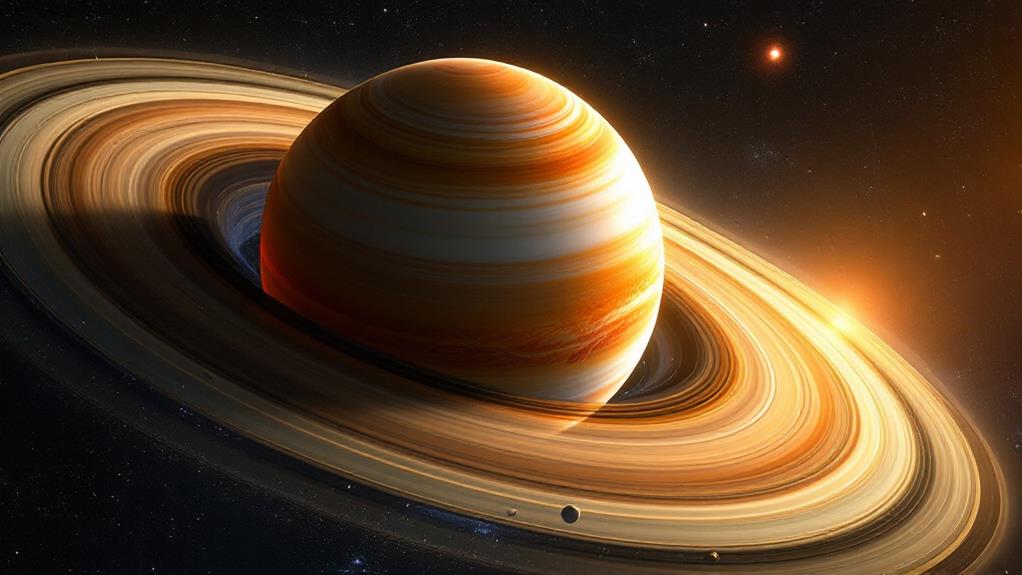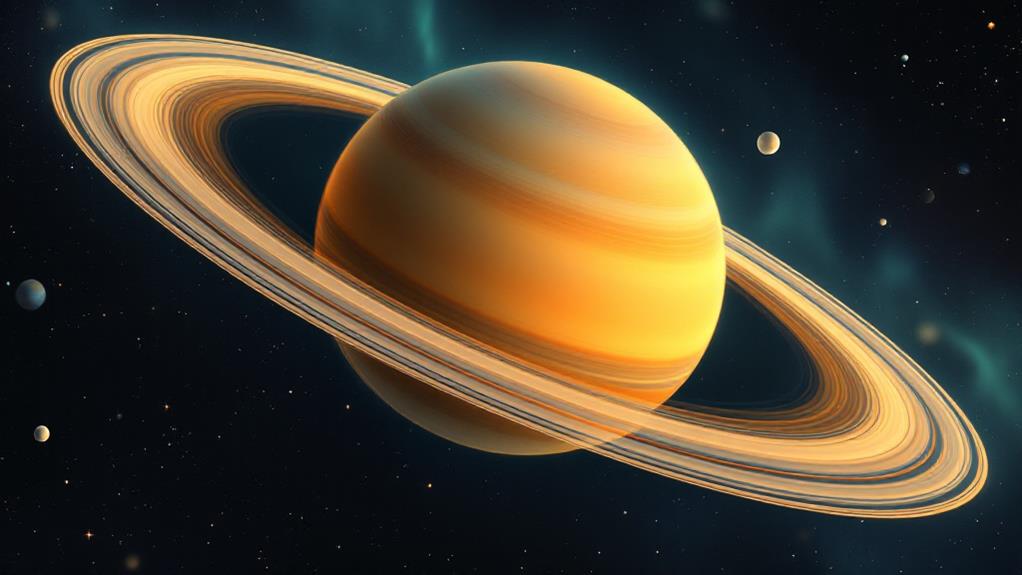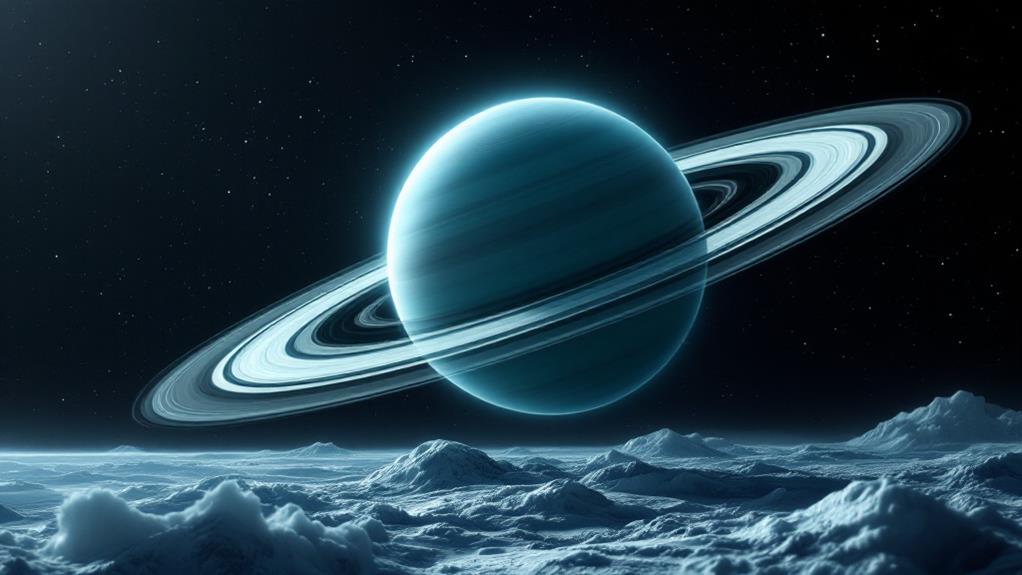Interesting Facts About Neptune: The Mysterious Ice Giant
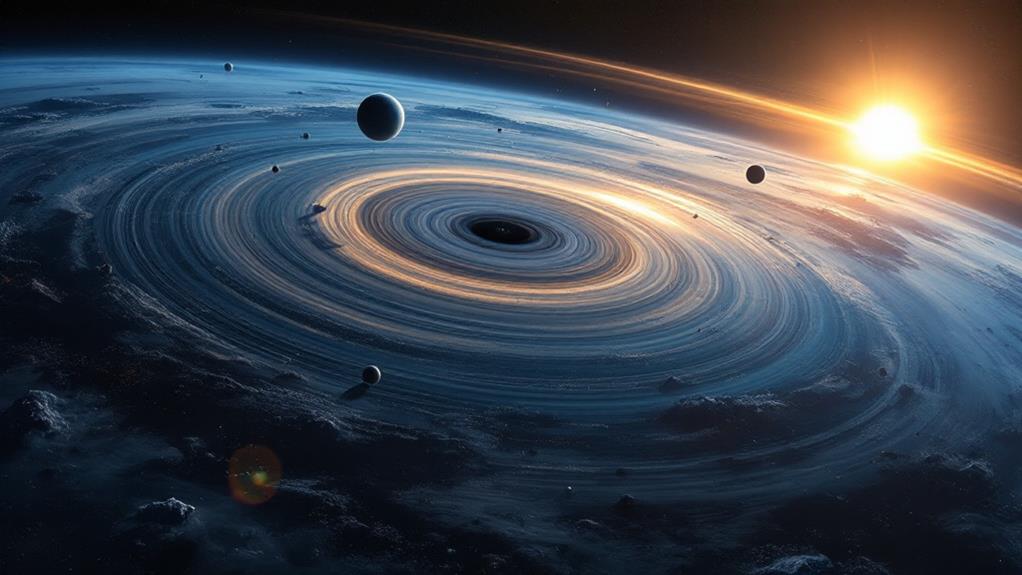
Neptune, the distant ice giant, will mesmerize you with its lively blue hue and extreme weather. You'll be astounded by its Great Dark Spot, a massive storm system the size of Earth, and winds reaching up to 1,500 mph. Neptune's faint rings and unique ring arcs add to its mystery, while its largest moon, Triton, boasts active cryovolcanoes. Unveiled through mathematical predictions, this planet emits more heat than it receives from the Sun and has a peculiar magnetic field. From its methane-rich atmosphere to its potential diamond rain, Neptune holds countless secrets waiting to be unearthed by future missions.
Neptune's Vibrant Blue Color
While many planets in our solar system exhibit various hues, Neptune's vivid blue color stands out as particularly striking. You'll find that this ice giant's appearance is due to its unique atmospheric composition. The planet's outer layers consist primarily of hydrogen, helium, and methane. It's the methane that plays a vital role in creating Neptune's signature blue shade.
As sunlight penetrates Neptune's atmosphere, the methane gas absorbs red light wavelengths and reflects blue light back into space. This process, known as Rayleigh scattering, is similar to what makes Earth's sky appear blue. However, Neptune's blue is much more intense due to its higher methane concentration.
You'll notice vibrant color variations across Neptune's surface, with some areas appearing darker or lighter blue. These atmospheric hues are caused by the planet's fluctuating weather patterns and storm systems. The Great Dark Spot, a massive storm observed by Voyager 2 in 1989, is one example of how these variations can manifest. Neptune's ever-changing appearance keeps astronomers intrigued as they continue to study this distant, mysterious world.
The Great Dark Spot
Speaking of Neptune's atmospheric features, one of its most famous is the Great Dark Spot. This massive storm system, first observed by NASA's Voyager 2 spacecraft in 1989, is a swirling vortex of dark clouds in Neptune's atmosphere. You'll be amazed to learn that it's roughly the size of Earth, stretching about 13,000 kilometers across.
The Great Dark Spot's movement is particularly intriguing. Unlike Jupiter's Great Red Spot, which remains relatively stationary, Neptune's storm system travels across the planet's surface. It can move up to 1,200 kilometers per day, showcasing the fluid nature of Neptune's atmosphere. The storm's size and shape also fluctuate over time, with observations showing it can shrink, expand, or even vanish entirely.
Scientists believe the Great Dark Spot is caused by differences in temperature and pressure in Neptune's atmosphere. It's a testament to the planet's extreme weather conditions, with wind speeds reaching up to 2,100 kilometers per hour. While it may have disappeared since its initial discovery, similar dark spots have been observed on Neptune, indicating that these massive storms are a recurring phenomenon on the ice giant.
Extreme Winds and Storms

Although Neptune's Great Dark Spot is impressive, it's just one aspect of the planet's extreme weather. You'll find that Neptune's atmosphere is home to some of the most violent storms in the solar system. The planet's winds can reach speeds of up to 1,500 miles per hour, making them the fastest in our cosmic neighborhood.
Neptune's extreme cloud bands are a testament to its tumultuous atmosphere. These bands are constantly shifting and changing, creating a dynamic and ever-changing appearance. The planet's extreme atmospheric pressure contributes to the formation of these intense weather patterns. As you explore deeper into Neptune's atmosphere, you'll encounter increasing pressure and temperature, which fuel the planet's powerful storms.
Massive storm systems, similar to Earth's hurricanes but much larger, are common on Neptune. These storms can last for years or even decades, driven by the planet's internal heat and rapid rotation. The planet's blue color comes from methane in its upper atmosphere, which absorbs red light and reflects blue light back into space. This unique composition adds to the visual spectacle of Neptune's turbulent weather systems.
Neptune's Rings and Arcs
Despite their subtlety, Neptune's rings are a fascinating feature of the ice giant. Unlike Saturn's prominent rings, Neptune's are much fainter and harder to observe. You'll find that these rings are composed of dust particles, ice, and rocky debris. Their diffuse nature makes them challenging to detect from Earth, which is why they weren't discovered until 1989 during Voyager 2's flyby.
Neptune's ring system consists of five main rings, each named after astronomers who made significant contributions to the planet's study. What's particularly intriguing is the unusual stability of Neptune's ring arcs. These are brighter, clumped sections within the outermost ring, Adams. Scientists believe that the gravitational influence of Neptune's moon Galatea helps maintain these arcs, preventing them from spreading out evenly around the ring. This phenomenon is unique in our solar system and continues to puzzle researchers. The rings' composition and structure provide insightful perspectives into Neptune's formation and evolution. As you investigate deeper into Neptune's mysteries, you'll find that its subtle ring system holds many secrets about the dynamics of planetary rings and their interactions with moons.
Triton: Neptune's Largest Moon
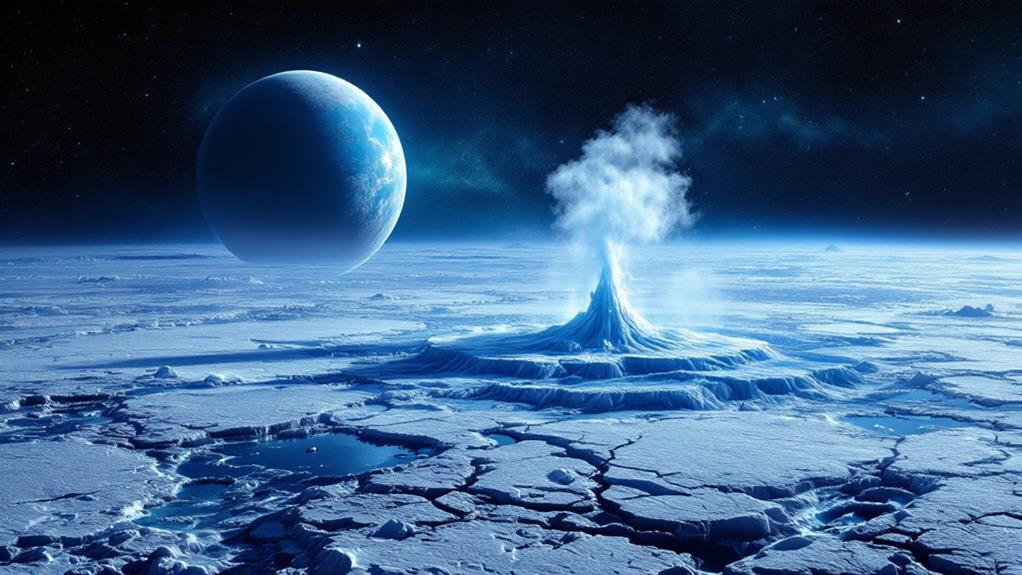
Triton stands out as Neptune's largest and most intriguing moon. It's the only large moon in our solar system with a retrograde orbit, meaning it circles Neptune in the opposite direction of the planet's rotation. This unusual orbit suggests that Triton wasn't born alongside Neptune but was likely captured by the ice giant's gravity.
You'll find Triton to be a fascinating world of extremes. It's one of the coldest objects in our solar system, with surface temperatures plummeting to -235°C (-391°F). Despite this frigid environment, Triton isn't a static, lifeless body. It boasts active geology, including cryovolcanism – the eruption of icy materials instead of molten rock. You can observe this phenomenon through Triton's impressive geysers, which shoot plumes of nitrogen gas and dust particles up to 8 km (5 miles) high. These geysers contribute to Triton's thin atmosphere and showcase its ever-changing nature. The moon's surface is a mix of frozen nitrogen, water ice, and dry ice, creating a unique terrain of smooth plains, ridges, and depressions. Triton's distinctive features and active processes make it a prime target for future exploration missions.
Neptune's Discovery and Naming
Unlike the other visible planets known since ancient times, Neptune's identification in 1846 marked a triumph of mathematical prediction and observational astronomy. The planet's discovery was a result of careful calculations based on irregularities in Uranus's orbit. Neptune's distance from the Sun, nearly 2.8 billion miles, made it impossible to spot with the naked eye.
Neptune's early astronomers played pivotal roles in its discovery and naming:
- Urbain Le Verrier, a French mathematician, predicted Neptune's position
- Johann Gottfried Galle, a German astronomer, first observed Neptune
- John Couch Adams, a British mathematician, independently calculated Neptune's location
- William Lassell discovered Neptune's largest moon, Triton, just 17 days after the planet's discovery
- Friedrich Georg Wilhelm Struve made the first accurate measurement of Neptune's distance from Earth
You might wonder about the planet's name. Neptune was named after the Roman god of the sea, following the tradition of naming planets after mythological deities. This choice was fitting, given the planet's blue color and its position as the last of the "classical" planets in our solar system.
Composition of the Ice Giant

Neptune's name and detection story set the stage for understanding its unique composition. As an ice giant, Neptune's structure differs greatly from the gas giants like Jupiter and Saturn. You'll find that it's primarily composed of ices, including water, ammonia, and methane, mixed with rocky material and a small iron core.
Neptune's atmosphere is predominantly hydrogen and helium, with traces of methane that give it its distinctive blue color. As you descend into the planet, you'll encounter a high pressure atmosphere that gradually transforms into a liquid mantle. This mantle consists of water, ammonia, and methane ices, along with dissolved rock.
Interestingly, Neptune emits more heat than it receives from the Sun, suggesting the presence of internal heat sources. Scientists believe this could be due to leftover heat from the planet's formation or ongoing chemical reactions within its core.
The planet's extreme pressure conditions may cause methane to decompose into diamond crystals, which could rain down through the mantle. This unique composition makes Neptune a fascinating subject for planetary scientists, offering observations into the formation and evolution of our solar system.
Neptune's Unusual Magnetic Field
Magnetic fields often hold surprises, and Neptune's is no exception. The ice giant's unusual magnetic field properties have puzzled scientists since its discovery. Unlike Earth's magnetic field, which aligns closely with its rotation axis, Neptune's magnetic field is tilted by a staggering 47 degrees. This extreme tilt creates a complex and dynamic magnetosphere that's unlike any other in our solar system.
Neptune's magnetic field generation mechanisms are thought to occur deep within the planet's interior. Scientists believe that the field is produced by electrical currents in a layer of electrically conducting fluid, likely a mixture of water, ammonia, and methane. This layer, under immense pressure, behaves more like a metallic fluid than an ice.
- It's 27 times stronger than Earth's magnetic field
- The field's center is offset from the planet's core by about 0.55 radii
- Its dipole axis is tilted at 47 degrees to the rotation axis
- The field undergoes rapid changes and fluctuations
- It interacts with the solar wind to create a unique magnetosphere
Understanding Neptune's magnetic field could provide observations into the planet's internal structure and composition.
Future Missions to Neptune
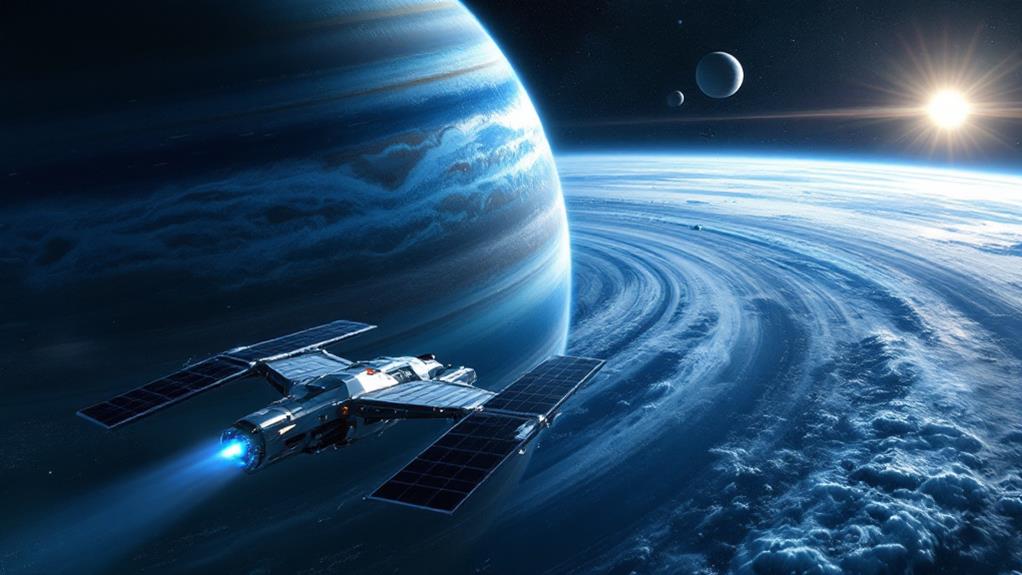
As we look to the future of space exploration, Neptune remains a tantalizing target for scientists. While no concrete missions are currently planned, space agencies are considering various proposals to study this distant ice giant. Future missions could focus on exploring Neptune's unique atmosphere, magnetic field, and ring system in greater detail.
One potential mission concept involves sending an orbiter to study Neptune's complex weather patterns and atmospheric composition. Scientists are particularly interested in understanding the planet's Great Dark Spot and its mysterious methane-rich clouds. Another possibility is a probe designed to investigate Neptune's largest moon, Triton, which could be an ocean world with potential for harboring life.
Mission science objectives might include mapping possible landing sites on Triton, studying Neptune's unusual magnetic field, and analyzing the planet's internal structure. Advanced instruments could provide unparalleled data on Neptune's composition and help decipher the mysteries of its formation. While these missions remain in the planning stages, they represent exciting possibilities for expanding our knowledge of this distant world and the outer solar system.
